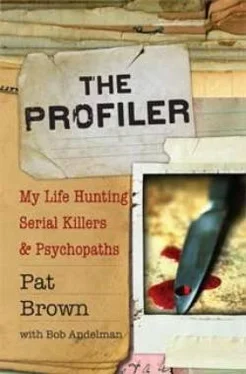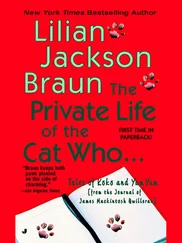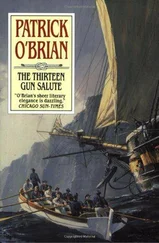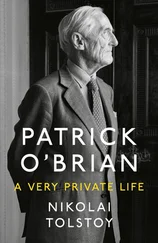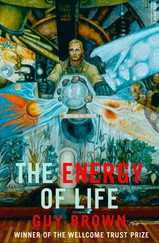Did anybody stop to look at the actual evidence to see what exactly happened in the home that day and then reconstruct all the available information to determine the culprit and nature of this particular crime?
We knew, without a shadow of a doubt, that somebody definitely stabbed that man and that woman to death. There was no question about that, and it was a very violent crime. Frank was stabbed numerous times, far more than was needed to kill him. Renee fought her attacker but ended up with her throat cut.
The police told the Washington family that Renee had human blood under her fingernails, having scratched her attacker. But if they knew whose blood it was, they never said.
We also knew that a knife was not found at the scene. We don’t know where the knife came from or where it went, so whoever did this took the knife away with him or her. We knew that.
We also know that the man-because of the blood spatter pattern and from the blood that was tested-was killed first, and the woman second. Therefore, the attack began in the living room with the man, and the second attack was on the female in the bedroom.
Of course, that doesn’t tell us who the target was; it just tells us that somebody came into the home and killed the man in the front room. Was he killed because the murderer was on his or her way to get to Renee and he had to get through Frank first, or was Frank killed and then somebody heard Renee in the bedroom and had to kill her, too? Therein lies the question.
I took a look back at exactly what happened over the preceding twenty-four hours.
The night before he died, Frank returned home by seven thirty p.m. from visiting a friend.
As for Renee, she was at her brother’s home until six thirty p.m. She left by herself and visited her mother until nine thirty p.m., knowing that if she was going to spend the night at Frank’s, she had to be there by ten or he wouldn’t let her in. Frank was stubborn about this. Her mother lived ten minutes away from Frank.
The time line itself was pretty intriguing. Donnell said that his son heard a thump in the living room, which upset Donnell. He told the police that he thought, If I had broken that door down earlier, perhaps I would have been able to stop this.
We could look at some physical evidence and find out whether Donnell was correct about that. Was there rigor mortis? Was there livor mortis? Rigor mortis is the stiffening of the body after death; livor mortis refers to the blood that settles in the body after death. If you’re facedown, it settles to your face and stomach; if you’re on your back, it settles to your back as gravity pulls it toward the earth. A smart investigator can identify this and sometimes tell how long a person might have been dead. It depends on how quickly the body is found, too. Then a forensic scientist, coroner, or medical examiner can tell the investigator the probable time of the person’s death.
There is also circumstantial evidence for when a person died, and what makes sense.
The Washington family said there were two interesting points that the police didn’t seem to consider. One is that the boyfriend, Frank, would never open his door to anybody if he did not know who it was. Whether his drug-dealing past had made him paranoid or he just didn’t like to open the door to people he didn’t know, he would not open his door to just anybody. And after ten p.m., he wouldn’t take a chance on anyone, not even his girlfriend-at least that is what the Washingtons claimed.
Frank was involved in some serious drug dealing; a year before the murder, he was caught in another city, in possession of marijuana valued at more than $150,000. A judge gave him probation and he was reported to have turned police snitch against his boss to avoid serious prison time.
Frank had taken the opposite path in life of his brother, Barry. Barry was the general foreman for the city, by all reports an upstanding citizen. Some speculated that the police didn’t solve the murder because it would shine a light on Barry’s brother’s unsavory activities.
When he died, Frank was trying a do-over in his own life, attending barber school in an attempt to learn a legal trade.
Donnell came over at one a.m. the night before to borrow his mother’s car because he did not have one; he was going to come back and pick up his mother for the funeral in the morning. He called the house that night and he said nobody answered, so he went over in person and knocked on the door. At least this time, Frank answered the door. And despite the late hour, he obviously did let Donnell in. Donnell borrowed the car and went on his way. Donnell was the last one to see them alive.
I looked at what was going on in the home in the hours before the double homicide. There was no breakfast on the table, no plates set out, no dirty dishes in the kitchen. Dinner was gone-if it had ever been prepared and eaten in the apartment-and it didn’t look like anybody had had breakfast yet.
Frank was on the sofa. He was dressed. He had on a pair of jeans and an undershirt, a long-johns type of shirt, and some soft slippers. He didn’t look like he was going out at that moment. It looked like he was hanging around the house.
Renee was dressed in panties and a silk nightshirt, and her sister, Donnell’s aunt, said, “My sister always laid out her clothes for the morning. That’s one of the things she always did. She laid out the clothes, what she was going to wear, everything ironed and ready to go. She was going to a funeral in the morning. If she had gone to bed, she would have definitely laid those clothes out.”
The most pressing question was no longer who did it but when did the murders actually happen? Did it happen in the morning after they had all gotten up, or did it happen before they went to bed?
Donnell was there sometime in the middle of the night…
I considered the possibility that the crime occurred when Donnell’s son said he heard a thump in the living room. But it is unlikely to be the time it happened. Still, even if it had, some rigor mortis would have set in. The fact remained that neither Frank nor Renee seemed like they had been to bed yet. This is circumstantial evidence, but I needed to think about its implications.
The next thing I wanted to do was check out everyone’s stories; where did they agree, where did they conflict? How accurate were their individual reports?
Donnell said when he returned to Frank’s home later in the morning, he busted in the door. This is one of the reasons I go to the scene of the crime whenever possible and see what I can still see. So I went to the boyfriend’s basement apartment.
To reach it, you had to go through a locked outside screen door and then walk downstairs and gain access through a sturdy locked door.
The apartment door itself had not been changed since the crime, and I could see absolutely no evidence that it was ever kicked in. I had pictures of the door from the scene, and I saw no evidence in those that the door was any different. What door did Donnell kick when he “broke the door down”? Where were the signs of damage?
Nobody paid attention to the fact that Donnell said he broke the door down, and yet the door was just fine and dandy. That lit a bulb in my head.
Next I wanted to see the interviews Donnell did with the police. One concerning issue was the CPR. He told the police that when he did CPR on his mother, he knew he shouldn’t have done that because he disturbed the scene.
“I knew I shouldn’t have done it, but I couldn’t help myself,” he said.
I thought, What a strange comment. Most people would think doing CPR was the right thing to do. If you thought there was a chance in hell of saving someone’s life, not much would get in your way. It would not have been wrong to move your mother’s body under those circumstances. And you probably wouldn’t say the words, “but I couldn’t help myself.” What an odd statement. I kept that statement in the back of my mind, because I thought it peculiar.
Читать дальше
